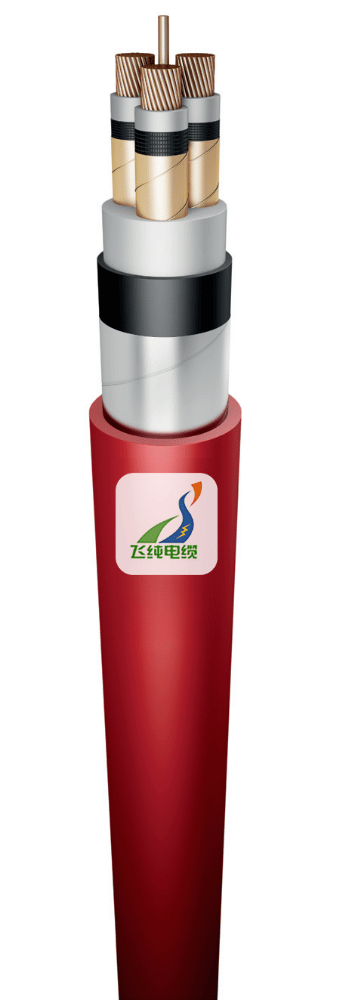Type YHKGYFtlyn 3.6/6 kV Mining Power cables
High performance mining power cable used underground, with individually shielded copper conductors, radial field
PVC insulation, PVC jacket, enameled steel tape armor, flame retardant PVC jacket


Type YHKGYFtlyn cable is a high-performance power cable designed specifically for underground mining applications.
It is engineered for use in electrical systems with a rated voltage not exceeding 3.6/6 kV, ensuring reliable operation in the demanding environments found in underground mines.
Construction and Materials
Conductors and Shielding
High-Quality Copper Conductors:
The cable uses Class 2, round, compacted copper conductors in accordance with EN 60228 standards.
Individual Shielding:
Each conductor is individually shielded with two copper tapes arranged in a radial configuration. This design minimizes electromagnetic interference and improves overall performance.
Insulation and Layers
Primary Insulation:
The conductors are insulated using a polywinit material (type DIV 14), compliant with PN-HD 620 S1:2002.
Non-Metallic Conductive Layer:
A conductive tape layer is applied, serving as a non-metallic component that enhances electrical performance.
Filling and Core:
Inside the twisted screen layers, an additional copper wire is positioned. A rubber blend filling layer is applied to ensure uniformity and structural integrity.
Sheath:
The cable features a polywinit sheath (type DMV 31, according to PN-HD 620 S1:2002) that provides primary mechanical and environmental protection.
Armor:
For additional protection, the cable includes an armor made of lacquered steel wires.
Outer Protective Jacket:
The final layer is a flame-retardant polywinit jacket that prevents the spread of fire.
Performance Characteristics
Temperature and Mechanical Properties
Operating Temperatures:
Conductor: Maximum operating temperature of +70 °C.
Installation: Can be laid in environments ranging from –50 °C to +50 °C.
Bending Radius:
The cable must be bent to a minimum radius of 20 times its outer diameter (20D), ensuring that mechanical stresses are within safe limits.
Test Voltage:
Each cable is tested at 11 kV to ensure insulation integrity and overall safety.
Visual and Packaging Details
Color Coding:
Insulation: Natural (uncolored).
Jacket: Red.
Packaging:
The cable is typically supplied on drums with standard lengths of 500 or 1000 meters, though alternative lengths and packaging options are available on request.
Standards and Compliance
Standard:
The cable conforms to the ZN-TF-202:2015 standard.
RoHS Compliance:
It meets RoHS91 requirements, ensuring restricted use of hazardous substances.
Electrical and Physical Specifications
Cable Construction Variants
For each cable size (indicated by the format "3xXX/YY"), the following parameters are specified:
Insulation Thickness (mm)
Sheath Thickness (mm)
Armor Thickness (mm)
Approximate Overall Cable Diameter (mm)
Approximate Cable Weight (kg/km)
Maximum Conductor Resistance at 20 °C (Ω/km)
For example, the 3x25/16 cable has:
Insulation: 3.4 mm
Sheath: 2.2 mm
Armor: 2.4 mm
Diameter: Approximately 43.7 mm
Weight: Approximately 3455 kg/km
Conductor Resistance: 0.727/1.15 Ω/km
Similar detailed specifications are provided for sizes such as 3x35/16, 3x50/16, 3x70/16, 3x95/16, 3x120/16, 3x150/25, and 3x185/25.
Current Carrying Capacity and Inductive Properties
A separate table details the following for various conductor cross-sections (in mm²):
Current Carrying Capacity (A) at an ambient temperature of +25 °C
Unit Inductance (mH/km)
Unit Inductive Reactance (Ω/km)
For example:
25 mm² Conductor:
117 A, 0.37 mH/km, and 0.116 Ω/km.
35 mm² Conductor:
141 A, 0.35 mH/km, and 0.110 Ω/km.
50 mm² Conductor:
168 A, 0.33 mH/km, and 0.104 Ω/km.The table continues similarly for 70, 95, 120, 150, and 185 mm² conductors.
Installation Considerations
Correction Factors for Parallel Cable Installation
When cables are installed in parallel on supports (i.e., multiple cables laid one above the other), the current carrying capacity provided in the tables must be reduced by the following correction factors:
1 cable: 1.00
2 cables: 0.93
3 cables: 0.90
6 cables: 0.87
9 cables: 0.86
Correction Factors for Elevated Ambient Temperatures
For ambient temperatures higher than +25 °C (for cables with a maximum operating conductor temperature of +70 °C), the following correction factors apply:
30 °C: 0.94
35 °C: 0.88
40 °C: 0.82
45 °C: 0.75
50 °C: 0.67
55 °C: 0.58
Applications
The Type YHKGYFtlyn cable is ideal for transmitting electrical power in underground mining environments. It is designed to operate in the harsh conditions typical of mines, including fluctuating ambient temperatures and challenging mechanical conditions. With its robust construction, flame-retardant properties, and compliance with strict standards, this cable ensures safe and efficient power delivery in critical mining applications.

Frequently Asked Questions (FAQ)
Q: What is the rated voltage of the Type YHKGYFtlyn cable?
A: It is designed for electrical systems with a rated voltage up to 3.6/6 kV.
Q: In which environments is this cable primarily used?
A: It is engineered specifically for underground mining applications.
Q: What type of conductors are used in the cable?
A: The cable features compacted, Class 2, round copper conductors in accordance with EN 60228.
Q: How are the conductors shielded?
A: Each conductor is individually shielded with two copper tapes arranged in a radial configuration, reducing electromagnetic interference.
Q: What kind of insulation does the cable use?
A: It employs polywinit insulation (type DIV 14) as per PN-HD 620 S1:2002 standards.
Q: What additional layers are included in the cable’s construction?
A: The cable includes a non-metallic conductive tape, a rubber blend filling, a polywinit sheath (type DMV 31), and an outer flame-retardant jacket.
Q: How is the cable armored for enhanced protection?
A: A layer of lacquered steel wires is used to armor the cable, providing extra mechanical strength.
Q: What is the maximum operating temperature for the conductors?
A: The conductors can operate at temperatures up to +70°C.
Q: What temperature range is suitable for cable installation?
A: The cable can be installed in environments with temperatures ranging from –50°C to +50°C.
Q: At what voltage is the cable tested for insulation integrity?
A: It is tested using an 11 kV voltage to ensure proper insulation and safety.
Q: What is the minimum bending radius specified for the cable?
A: The minimum bending radius is 20 times the cable’s outer diameter (20D).
Q: Which standard does the cable conform to?
A: It meets the requirements of the ZN-TF-202:2015 standard.
Q: How does the cable's outer jacket enhance safety?
A: The outer jacket is made of flame-retardant polywinit, which prevents the spread of fire.
Q: What colors are used for the insulation and the outer jacket?
A: The insulation is in a natural color, and the jacket is red.
Q: What are the standard packaging options available?
A: The cable is usually supplied on drums in lengths of 500 or 1000 meters, with custom lengths and packaging available on request.
Q: Is the cable compliant with RoHS directives?
A: Yes, it meets the RoHS91 requirements, ensuring limited hazardous substance content.
Q: How does the cable manage high current loads?
A: Its robust construction—including high-quality insulation, individually shielded conductors, and reinforced armor—ensures excellent current carrying capacity.
Q: What role does the individual conductor shielding play?
A: The individual shielding minimizes electromagnetic interference (EMI) and cross-talk, which is critical in environments with high electrical noise.
Q: What variations in conductor sizes are available?
A: The cable is offered in several sizes, such as 3x25/16, 3x35/16, 3x50/16, 3x70/16, 3x95/16, 3x120/16, 3x150/25, and 3x185/25.
Q: How do ambient temperatures affect the cable's performance?
A: Higher ambient temperatures can reduce current carrying capacity, which is why correction factors are applied for temperatures above +25°C.
Q: How are correction factors applied for cables installed in parallel?
A: When multiple cables are installed together (stacked on supports), current capacity values must be reduced by specific correction factors (e.g., 1.00 for one cable, 0.93 for two, 0.90 for three, etc.).
Q: What is the significance of using compacted copper conductors?
A: Compacted conductors provide lower electrical resistance and enhanced current carrying capacity, which is essential for high-power mining applications.
Q: How does the cable reduce the risk of overheating?
A: Its design, including efficient insulation and adherence to correction factors for high ambient temperatures, ensures effective thermal management.
Q: What are the typical unit inductance and inductive reactance values?
A: These values vary by conductor cross-section; for instance, a 25 mm² conductor typically shows around 0.37 mH/km inductance and 0.116 Ω/km reactance.
Q: How does the cable’s armor contribute to its durability?
A: The lacquered steel wire armor protects the cable against mechanical damage, making it suitable for the rigorous conditions found in mining operations.
Q: Can the cable handle mechanical stresses common in mining environments?
A: Yes, its robust construction and reinforced layers are specifically designed to withstand mechanical stresses and vibrations encountered in underground mines.
Q: What maintenance is recommended for the cable in mining installations?
A: Routine inspections for physical damage, environmental wear, and periodic electrical testing are advised to ensure continued safe operation.
Q: How does the cable manage electromagnetic interference in high-noise environments?
A: The individually shielded conductors and radial field design help to minimize interference and maintain signal integrity.
Q: What is the approximate overall diameter and weight of the cable?
A: These parameters vary with cable size; for example, the 3x25/16 version has an overall diameter of about 43.7 mm and weighs roughly 3455 kg/km.
Q: What measures are in place to ensure electrical safety in underground mines?
A: The cable’s construction—featuring high-quality insulation, individual shielding, flame-retardant jacket, and rigorous testing—ensures high levels of electrical safety.
Q: What is the purpose of the non-metallic conductive tape in the cable?
A: It serves as an additional conductive layer, enhancing overall electrical performance and stability under demanding operating conditions.






Type YHKGYFtlyn 3.6/6 kV Mining Power Cable
A high-performance, underground cable engineered for the demanding conditions of mining environments. This robust cable features individually shielded copper conductors, advanced polywinit insulation, and a flame-retardant, armored outer jacket, ensuring reliable electrical performance and safety. Designed to operate in temperatures from –50°C to +70°C and tested at 11 kV, it meets strict ZN-TF-202:2015 standards. With its efficient design and versatile packaging options, this cable is the ideal choice for effective power distribution in underground mining applications, delivering durability, safety, and high efficiency.
6/30/20216 min read
